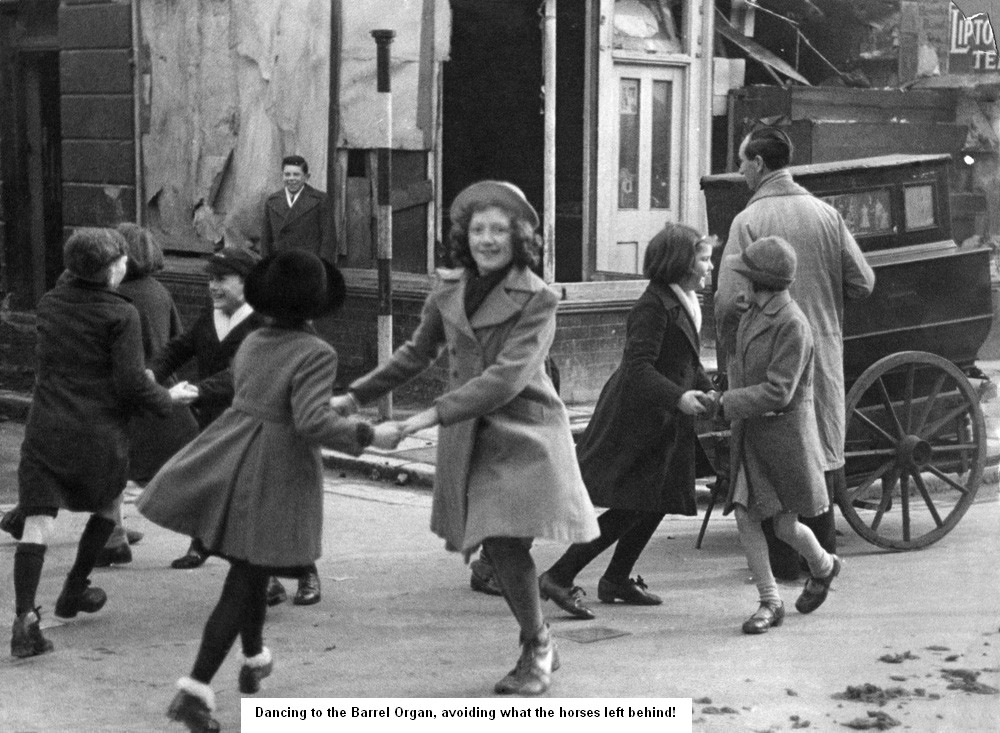Our own locality was generally the place we shopped, so a trip to ‘town’ was rather special. Some trolley buses still ran on the 88 route, and if I could persuade mum to go upstairs, it made the trip even better.
Although logic tells me it isn’t true, it was always a winter afternoon when we were in town.

The bomb site on one side of Piccadilly was a legacy of the Christmas blitz of 1941. However the gardens remained the town centre to us, and the illuminated signs on the opposite side kept our eyes averted from the devastation. Colourful neon lights exhorted us to ‘walk the Barratt way’, and a huge clock announced Guinness was good for us. In those pre-mobile phone days, many people used the flashing Mother’s Pride sign as a designated meeting point. And to keep you occupied while waiting, there was a newsfeed spooling across the building facades on a rolling display. There must have been traffic noise, but I remember the predominant sound as the Murmuration of thousands of starlings roosting on high window sills.
There must have been traffic noise, but I remember the predominant sound as the Murmuration of thousands of starlings roosting on high window sills.
In those days, whatever the size, shops each had some USP (unique selling point) to tempt us inside. Whether you were looking for a kitten or an alto saxophone, Tib Street was the place to go. It was just one of the many narrow back streets teeming with shops supplying items not stocked by the larger stores. However the department stores’ magnificent window displays acted like a magnet. Once inside, the interiors were a symphony of polished wood, brass, and occasionally marble. Even the toilet facilities seemed opulent. With their own banks, cafes, and hairdressing salons, the stores were a sophisticated microcosm of the streets surrounding them.
However the department stores’ magnificent window displays acted like a magnet. Once inside, the interiors were a symphony of polished wood, brass, and occasionally marble. Even the toilet facilities seemed opulent. With their own banks, cafes, and hairdressing salons, the stores were a sophisticated microcosm of the streets surrounding them.
I liked going into Henry’s because it had a moving staircase (escalator). It’s difficult to imagine, but travelling in a lift was then still something of a novelty. A uniformed man (often a disabled war veteran) operated the switches whilst calling out each floor’s merchandise.
In the fifties, to find a street market and an ancient black and white building standing alongside Georgian warehouses, or a modern office block, was not unusual. It was simply a glimpse into the different phases of Manchester’s commercial history.
If our elderly hens needed replacing, we headed for Shudehill market on Sunday morning. I recall sitting on the steps of an old building, once the Rovers Return Inn, while granddad checked out each bird. Finding a building of such antiquity in the middle of ‘town’ was what kick-started my interest in the past. Another historical landmark I liked was the statuary on one of the cotton offices. Two figures I called ‘the dirty ladies’ reclined across the top of an ornate portico. My name for them didn’t refer to their state of undress, but rather the blackening caused by the smoke from nearby mill chimneys. Henry’s was about as far down Market Street as we usually ventured. We had Woolworths, C&A, Affleck & Brown, M&S and Littlewoods, not to mention as many shoe shops as you could wish for, on Oldham Street and Piccadilly.
Henry’s was about as far down Market Street as we usually ventured. We had Woolworths, C&A, Affleck & Brown, M&S and Littlewoods, not to mention as many shoe shops as you could wish for, on Oldham Street and Piccadilly.
The other outer limit for shopping was New Cross, once part of the area known as Little Italy. Many Italian street musicians lived there in the 1800s, so it seems appropriate it was the place I last heard a barrel organ. Masons was one of the largest shops on the Oldham Road side of Victoria Square (aka the Dwellings).
While my parents were busy choosing oilcloth (linoleum), I was spellbound by the organ grinder doing his stuff at the Bengal Street entrance to ‘the Dwellings’. With no access to recorded music, little girls like my nana danced around barrel organs. I like to imagine the elderly flat dwellers sighing as they were transported back to childhood days. By the fifties, Manchester’s motto seemed to be ‘progress at any price’. That apparently meant the sacrifice of the Rovers Return Inn, and the multiplicity of small businesses trading out of buildings up to 200 years old, which effectively drained the life from the area now known as the Northern Quarter.
By the fifties, Manchester’s motto seemed to be ‘progress at any price’. That apparently meant the sacrifice of the Rovers Return Inn, and the multiplicity of small businesses trading out of buildings up to 200 years old, which effectively drained the life from the area now known as the Northern Quarter.
Bricks and mortar were not the only thing which disappeared when small businesses and workshops were demolished. We lost the irreplaceable skills of rag trade workers, manufacturing jewellers, tailors, picture framers and ticket writers. And suddenly there was nowhere to get shoe, umbrella, watch and electrical repairs done.
Today not even a ride on a trolley bus could get me excited about going to ‘town’.